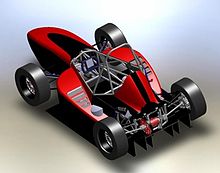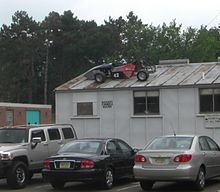Rutgers Formula Racing
 | |
| Established | 1988 |
|---|---|
| Students | Approximately 30 total members including about 15 core members |
| Location | , , |
| Website | http://rfr.rutgers.edu |
Rutgers Formula Racing (previously known as Rutgers Formula SAE) is a collegiate club within the Rutgers University School of Engineering which competes in the Formula SAE Design Series.
History by Year
1988
Initial start of team.
1989
1990
1991
1992
1993
Rutgers did not compete in the Formula SAE competition in 1993.
1994
Rutgers entered its first carbon fiber monocoque in the 1994 competition. The front half of the car was constructed of pre-preg carbon fiber with a Nomex honeycomb core. 3 sandwich panel aluminum bulkheads were used to mount the front suspension and master cylinders. The rear half of the car was constructed of 4130 steel tubing. One of the most dramatic features of the car was the use of very long lower A-Arms. They were so long, that there was only about 1 inch of space between the left and right mounts on the chassis. The composite construction made use of very simple molds made primarily from sheetmetal and wood. There were no compound curves to any of the molds for the monocoque. Shifting was performed via pneumatics. The brakes used 200mm OD cast iron vented rotors. The engine was a naturally aspirated Kawasaki Ninja 600R, making 73 RWhP.
Result Highlights:
Presentation - 7th Place,
Design - 13th Place,
Acceleration - 13th Place,
Skid Pad - 5th Place,
Autocross - 3rd Place,
Endurance - 7th Place (22 Cones and 3 spin outs),
Economy - 6th,
Overall - 9th
1995
1996
1997
1998
1999
2000
2001
2002
The team placed 17th overall.
2003
Completion of the car was very far behind. The car was ultimately able to pass all parts of tech inspection in time to be the very last car to run endurance. The chain fell off in the next to last lap of the event (second driver) due to the retaining clip on the master link falling off. This car had a chain which rubbed a friction surface on an interfering chassis tube, which may have contributing to knocking the clip off.
After the competition the interfering tube was cut out with a reciprocating saw and a diagonal tube was welded in so that the chain did not interfere. This setup lasted many drive days until eventually causing a crack in one of the original chassis tubes.
The car used a custom designed electronic shifting actuator made from a standard RC car motor and a planetary gear box from a power drill. While the actuator was very powerful, the system required an electronic controller because the motor could not be turned on for more than a quarter second without damaging the brushes or windings. The overall actuator weight was around 1.2 lbs. There was positive and negative results of the system. With new brushed in the motor and proper tweaking it was capable of very fast shifter (~15 ms), and was able to perform very well for automatic up-shifting during acceleration runs. However, the brushed motor was unreliable under this type of use (very low rev, turning only a few turns at a time, commonly stalled), which meant that the motor required constant tinkering. Further problems included the use of 1st gear on this car which led to frequent neutral-out conditions.
2004
2005
2006
2007
2009

There was notable redesign of most systems creating an overall new "platform". The Yamaha R6 engine was replaced with the 2007 Honda CBR 600rr. Anti-squat, and anti-dive were added to the suspension kinematics. The aluminum rear subframe was scrapped and the chassis was reverted to a one piece steel tube design. The team competed in two competitions, VIR and MIS. Highlights were 3rd place in Acceleration at VIR, and a tie for 3rd place in Design at MIS. The MIS Design finish was originally a tie with one other team for 5th place after semi-finals, two of the Design finalists had a 35 point penalty for not passing the new template rules, causing the first place team to tie with the two 5th place teams for 3rd place in points.
A paddle actuated hydraulic clutch was designed which had a custom master cylinder concentric with the steering shaft. Shifting was originally via a large off-the-shelf electric solenoid (actually two solenoids inline which acted in opposite directions), but the windings for one of the internal solenoids burned out the Sunday before the VIR competition (the team left on the Tuesday morning after this). Parts were gathered from old (~10 years previous or more) pneumatic shifting setups that were stored in various places, and the following day CO2 tanks and various other parts were bought at a paint ball supply store and a pneumatic shifter was on the car by 4am Tuesday morning. This system used the same switches that actuated the original shifter, which were mounted on a collar on the steering shaft. The shift paddles pushed small pushrods which were in holes drilled in the quick release and protruded when the paddle was pulled to push the microswitch levers.
Other notable events in 2009:
First time the shop in the Packaging Engineering Building was used as a main shop. The chassis was build in this shop and carried out the single door before the final assembly of the car.

Addition of the "car on the roof". This is the chassis and body of the 2003 car which has been strapped to the roof of the shop with wire rope.
Testing at the Goodyear facility in Akron, Ohio in October, 2009.
Organization
Rutgers Formula Racing, as of June 2009, has the following administrative structure:
Faculty Advisor
Team Captain
Team President
The Team Captain and President are in charge of the team overall. They have different but sometimes overlapping responsibilities, and have equal authority. The Team Captain is responsible for getting the car built. He/she tends to resolve design contentions, acts as a technical interface between the people designing the systems of the car, and sets the priorities of the team. The Team President is responsible for the finances of the team, and deals with logistics regarding the University, and SAE.
Before June 2009: The Team Captain was known as the Team Leader. The roles of Vice President was assigned on and off, and no clear role was defined.
Project Leaders Project Leaders are responsible for the design and fabrication of the major systems of the car. Some years have additional or fewer specific projects leaders, but in general they are as follows: Chassis, Powertrain, Drivetrain, Controls, Electronics
Before June 2009, Project Leaders were referred to as Team Leaders of Sub-team Leaders.
Vice President The Vice President is a support role for the President.
Project Manager The Project Manager is a support role for the Team Captain. He/she keeps track of every individual project related to the design and fabrication of the car, and reports the status of the projects to the Team Captain.
This title was first used in 2007, but the job was not clearly defined until June 2009.
Treasurer
Funding
Each "year" or "season" runs from June to May of the next year. For example the 2000 season would run from June 1999 to May 2000. The major categories for funding sources are funds from the University, private sponsors, and member contributions. The majority of University funding comes from the Engineering Governing Council (EGC). Other University entities have offered funding in some years, such as the Mechanical Engineering Department, the Alumni Association, and others.
Approximate Funding by Year
2009 University related funding ~ $7000; Sponsorship ~ $5000; Member contributions ~ $12000
See Also
http://students.sae.org/competitions/formulaseries
http://www.lsasso.com/index_files/bsd.htm
